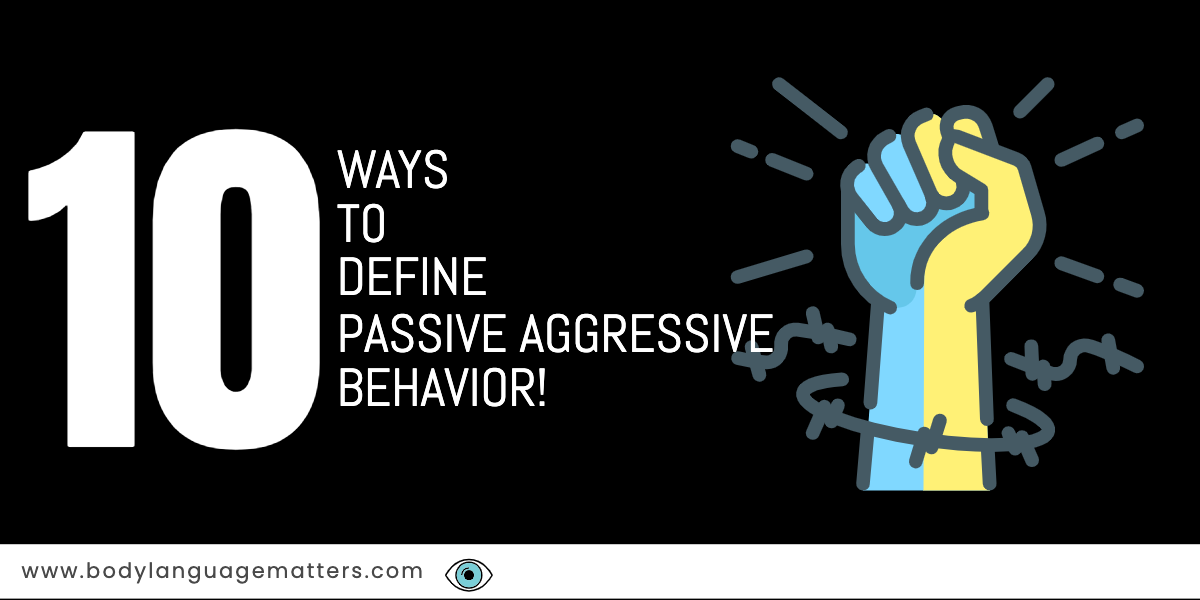What is passive-aggressive and how can we define it?
Passive-aggressive behavior is a form of behavior where someone expresses their feelings or frustrates in a indirect way instead of openly. This type of behavior often manifests when someone is feeling powerless or is unable to express their feelings directly. It can be in the form of a compliment followed by a sarcastic remark.
Some common examples of passive-aggressive behavior include:
- Sarcasm.
- Giving backhanded compliments.
- The silent treatment.
- Procrastination.
- Playing the victim.
- Withholding information.
Passive-aggressive behavior can be defined as saying something positive but not meaning it, with a negative undertone. We say something positive with a angry tone or negative body language. It’s all about the tone of you expression that can make you seem like you’re passive aggressive towards others.
Passive-aggressive behavior can be a form of manifestation of aggression that is veiled in the guise of being cooperative, agreeable, or understanding. We’re going to take a look at 12 ways to recognize passive aggression.
- What is passive-aggressive and how can we define it?
- 10 Ways to Define Passive-Aggressive Behavior.
- How To Handle Passive Aggressive People.
- Questions And Answers.
- What is unintentional passive-aggressive behaviour?
- What is a malicious passive-aggressive person?
- What are some examples of passive-aggressive behavior?
- Why do people engage in passive-aggressive behavior?
- What are the consequences of passive-aggressive behavior?
- How can you deal with passive-aggressive behavior?
- What does it mean to be passive-aggressive?
- How can you tell if someone is passive-aggressive?
- Summary
10 Ways to Define Passive-Aggressive Behavior.
Slient Treatment.
Some people get angry and they want to hit or scream at someone. They might not be able to contain their anger and they might want to lash out. Other people might just ignore the other person because that’s the best way for them to handle the situation. Slient treatment is when someone ignores you, they might act as if they didn’t even know you existed by not acknowledging your presence.
For example, if you ask them a question and they ignore you or walk out of the room when you enter, they’re trying to change your emotional state. They want to let you know they’re angry with you without saying it. There are ways around this we will talk about this some more below.
Backhand Compliments.
A backhanded compliment is a compliment that seems insulting on the surface. They are often given as a way to point out flaws in the other person, but they can also be used to point out positive qualities that may not be readily apparent on the surface.
An example of this is “You look great, for your age.” It’s a compliment, but if you remove the age thing, then you wouldn’t be really. It’s designed to make you question yourself and definitely a passive-aggressive behavior.
Withholding.
Withholding things, like time, money or information. When someone withholds something you are used to getting or allowing you to stumble into a trap and they had the information then this a classed as passive-aggressive behavior. Has anyone ever withheld something from you?
Avoiding Issues.
Purposely avoiding any issues in relationships or not wanting to talk about topics that are important to you. This can be frustrating on many levels, because you have something important to say but they don’t want to listen or address the issue.
Learned Helplessness.
Learned helplessness is pretending like they can’t do something when in fact they just don’t want to. For example, when I ask my husband to clean the bathroom and he cleans around the bottles of products. He’s done a really bad job so you don’t ask again.
This is a tricky passive-aggressive behavior, and one you should pay attention to. This kind of behavior might seem harmless, but it can cause harm to the individual and those around them.
Lateness as a weapon.
The game of power and control is a dangerous game to play. When one person deliberately turns up late, they are sending a message that you don’t control them and they can do whatever they want. They are in control of the other person’s time, so make sure you have your own life outside of them so it won’t be destroyed by their selfishness.
Gossip.
Gossip is a form of social communication where people share information about others in order to share knowledge and opinion. Malicious gossip can be considered as a form of verbal abuse, in which the one doing the spreading of gossip intends to harm someone’s feelings or reputation.
A passive-aggressive person will use malicious gossip to make you or others believe something bad about you or your life.
To Busy.
If you planned something and they know it’s something you want to do, like a family meal, work nights out, or a birthday party and your partner says they are too busy with a project for work when they had plenty of time to complete the task beforehand, this is called forced business.
When someone is being passive aggressive, they do not answer your question or agree to participate in a request. Rather than say no, they will put blocks in place to stop the person from going somewhere with them. It can be done by forgetting obligations, showing up late for events, and making requests impossible so that the other person loses interest.
Intentional Annoyances.
International annoyance is when someone does something to you when you’ve asked them not to. For example: you have asked your partner to place their shoes in a basket and not leave them in the bedroom, and they deliberately take off their shoes in the bedroom and leave them there. This is intentional just to p**s you off.
Control As Concern.
Someone doesn’t like what you’re doing and rather than telling you what they don’t like about it, they’ll act concerned about you and try to get you to change with empathy.
How To Handle Passive Aggressive People.
Control your emotions before you respond.
The first thing you need to do is take control of your emotions so that you don’t come from an emotional state. If you notice your blood starting to boil or you are becoming angry or frustrated, it’s time to walk away, calm yourself down and get back into your normal self. Don’t let the passive-aggressive person get to you.
Communicate From A Calm State.
Be cool, calm and collected in your thought process. Once you have a level head on your shoulders its time to tackle the passive aggress behavior.
State What You’ve Heard.
If you know what they’re trying to say but they won’t say it directly to you, say what they are trying to say. An example would be: passive-aggressive statement “You look great for your age” Your response would be “I look old and that’s a shame?” or something along those lines.
If You Don’t Know What They Are Getting At.
If you don’t know what they are trying to say or getting at, you could say something like, “It feels like there is something going on here” or “There feels like there is something going on behind the sarcasm.” Whatever it is say the lines “It feels like there is something going on here”
You have to come from this angle from a calm place. If you challenge this back with anger or sarcasm, that person will just build on what they have said and provoke the response they want.
Open The Door.
You could simply ask what the issue is. “Do you have a problem with me?” Be careful of their response.
Don’t Be A People Pleaser
You may not know it, but people are usually passive-aggressive with you because they are scared to be direct with you. They hope that their passive aggression will go unnoticed and they can get away with it. The best way to stop people from being passive-aggressive with you is to just be direct with them. If they were honest in the first place, then this would never have happened.
Questions And Answers.
What is unintentional passive-aggressive behaviour?
Most unintentional passive-aggressive comments are made by people who are too afraid to lose (relationships) something or who don’t want the confrontation. They’re not doing it in a malicious way; they’re doing it subtly to vent some kind of frustration.
What is a malicious passive-aggressive person?
Malicious, passive-aggressive people do things deliberately. They will use the above tools to manipulate you. This is dangerous people to be around, they tend to be deceptive and calculating in their approach.
What are some examples of passive-aggressive behavior?
Passive-aggressive behavior can take many different forms, but some common examples include making snide or sarcastic comments, sulking or withdrawing from social interactions, habitually being late or failing to complete tasks, and deliberately doing things that will annoy others. Passive-aggressive behavior is often a way of indirectly expressing feelings of anger, frustration, or resentment.
Why do people engage in passive-aggressive behavior?
It is often used as a way to express feelings of anger or frustration. People who engage in passive-aggressive behavior may do so because they feel unable to directly express their feelings, or because they believe that it is a more effective way to get what they want.
What are the consequences of passive-aggressive behavior?
The consequences of passive-aggressive behavior can be serious. It can damage relationships, create an environment of mistrust and suspicion, and lead to conflict. It can also lead to feelings of resentment, anxiety, and low self-esteem.
How can you deal with passive-aggressive behavior?
There is no definitive answer to this question as it depends on the individual situation. However, some tips on how to deal with passive-aggressive behavior include:
- Try to understand the root cause of passive-aggressive behavior. This could be due to insecurity, fear, or feeling powerless.
- Express your feelings directly to the person exhibiting passive-aggressive behavior. This helps to assert yourself and also let the other person know how their behavior is impacting you.
- Set boundaries with the person. This could involve saying no to requests that are unreasonable or setting limits on how much you will tolerate their behavior.
- Avoid reacting to the passive aggressive behavior. This will only escalate the situation and give the person the attention they are seeking. Acknowledge the behavior, such as “I appreciate your honesty,” or “It sounds like you feel that way.”Do not expect them to change their behavior.
What does it mean to be passive-aggressive?
To be passive-aggressive means to express oneself indirectly through actions or behaviours rather than through words. This can manifest as sullenness, resentment, procrastination, or deliberate or repeated Forgetting of important information.
How can you tell if someone is passive-aggressive?
Some common signs that someone may be passive-aggressive include making snide or sarcastic comments, intentionally doing things badly or slowly in order to spite someone, or refusing to communicate directly. Additionally, passive-aggressive people often have difficulty expressing their anger openly, and may bottle it up instead. If you suspect that someone may be passive-aggressive, the best course of action is to talk to them directly to see if they are willing to openly discuss the issue.
Summary
Passive-aggressive defined behavior is a way of indirectly expressing oneself through actions or behaviors rather than through words. This can manifest as sullenness, resentment, procrastination, or forgetting important information.
If you think someone may be passive-aggressive, the best course of action is to talk to them directly to see if they are willing to openly discuss the issue. If you have enjoyed reading this article, we recommend you check out our similar post here.

